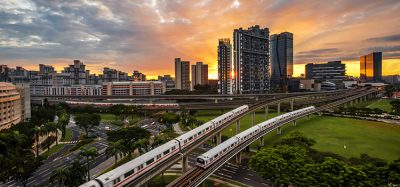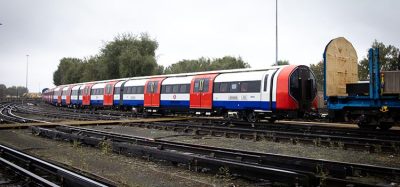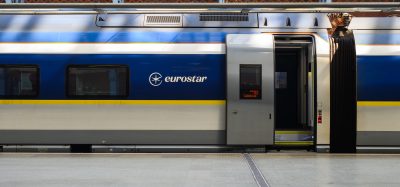Substantial plans to ensure Italy’s development
Posted: 30 July 2007 | | No comments yet
Ferrovie dello Stato’s business plan for 2007-2011 was approved by the Government on 4 May 2007. It is a development plan, a turning point and a real revolution from a quality point of view, with the aim of re-launching the Group on the domestic and European market and turning it into one of the major […]
Ferrovie dello Stato’s business plan for 2007-2011 was approved by the Government on 4 May 2007. It is a development plan, a turning point and a real revolution from a quality point of view, with the aim of re-launching the Group on the domestic and European market and turning it into one of the major players in a competition which is becoming tougher every day.
A key element of the Plan is the traffic growth, which we estimate to be around 34% for regional transport, 14% for medium/long-distance journeys and 19% for freight transport.
These are significant figures, which are supported from the start of 2010 by the completion of the new Turin – Milan – Naples High-Speed/High Capacity line – a project with a high technological content, which is absolutely essential if we are to meet the challenges in the Italian transport sector over the coming years.
At that date, it will be possible to travel from Naples to Milan and Turin in just over four and five hours, respectively, whilst the journey from Rome to Milan will take only three hours. This will represent a real revolution in the Italian transport system.
It is already possible, thanks to the two high-speed lines already activated, to reach Rome from Naples in 1 hour and 20 minutes instead of 2 hours (and in just 1 hour when the project has been completed) and the journey from Turin to Milan takes 1 hour and 22 minutes. A pair of trains also connects Genoa and Milan every day in just over an hour and another pair connects Milan and Venice in two hours.
We are changing the urban geography: the Naples-Rome and Genoa-Milan sections will be covered in the same time that it takes to travel from one side to another of a large city.
The HS network will create catchment areas for millions of people, highlighting the specific nature of Italy of being a country with many large towns located relatively close together.
The benefits of the High-Speed rail system are not merely reductions in journey times. Thanks to the progressive transfer onto the new network of the high-speed trains and part of the freight trains, it will be possible to improve the quality of the local and metropolitan services, both in terms of frequency and punctuality.
This is one of the main advantages which the High-Speed/High Capacity project will bring to the entire Italian rail transport system. It will free up space on the conventional routes, which are currently at the limit of their capacity.
For medium and long distance journeys with the new High-Speed lines, the increase in supply on the Turin- Milan-Naples route will be between 130% and 150% and, thanks to the innovative technological systems for network management, we expect to increase from 9,000 to 20,000 million passengers/km in 2010 when the HS system is fully operational.
If there is a positive response from the passengers, we expect that there may be approximately 30 departures a day on the 950km of the Milan-Turin High-Speed route, whilst it may be expected to reach 100 trains a day between Milan and Rome, which is similar to the frequency on the Paris- Lyon route.
In order to support this growth, considerable attention must be paid to improving the quality of the service. Probably the most significant aspect included in the Plan is the thorough upgrading of the fleet of trains. It is expected that €6,400 million will be used for approximately 1,000 new trains to be used for regional transport and €2,400 million for the medium to long distance journeys, of which €2,000 million for High-Speed trains.
This is a considerable financial investment but it is absolutely essential, as it will give visible and tangible results and will have a positive effect on the image of the Group as seen by millions of passengers travelling on our trains every day.
With regard to the infrastructures, the objectives of the Plan are focused on the development of the infrastructure capacity along the national and international corridors and at the metropolitan nodes, and on maintaining European leadership in the rail traffic safety sector.
The infrastructure upgrading and development investments for the urban and metropolitan nodes amount to €2,600 million. The Plan concentrates, in particular, on reducing the traffic congestion at three large urban nodes (Milan, Rome and Naples) which are real network bottlenecks. With the construction of specific Interconnections, our challenge will be to increase the share of rail transport in these cities up to 40%. The planned investment on the TEN corridors (trans-European network) amounts to €3,800 million.
The construction of five new stations is also planned (Turin, Bologna, Florence, Rome, Naples) which will change the town-planning layouts of the surrounding territory, making the transport system in the most important urban centres more modern and ‘European’.
Another objective with regard to the development of the network infrastructure is the specialisation of the lines in terms of types of traffic (metropolitan, medium-long distance journeys and freight).
Another important chapter in the FS strategy for the coming years includes new activities in the logistics sector (with the supply of integrated services), in urban services (from car parks, to the integration of the service with other forms of transport such as taxis and buses, and information to the public), in the real estate sector (with a more remunerative use of the properties not directly connected with railway activities), and in the overseas engineering services.
These are activities for which the FS Group has the necessary know-how and entrepreneurial skills to launch major challenges on the market.
Let us consider the Logistic Sectors. We are carrying forward a plan of in-house mergers, definition of alliances with other major enterprises and acquisition of operators. We have acquired, through Trenitalia, the majority shareholding in Tx Logistik, which is the second largest private German rail company operating in the logistics sector. With this acquisition we will be able to offer rail services from Northern Europe down to the Mediterranean.
The Urban Services open another interesting chapter. Above all, there are the railway stations, which we are gradually transforming into service centres for the city, following the model of Rome Termini. And we have also exported this model abroad. In the Czech Republic, for example, we have already acquired the project, through our subsidiary company Grandi Stazioni, for reconstruction of the stations in Prague, Karlovy Vary and Marianske Lazne and we are looking with interest to the development of Eastern European countries, including Russia. There is then everything that revolves around the station, in terms of parking, passenger services, etc.
The Real Estate assets represent another important source of income. Our portfolio of valuable properties located in strategic locations can form a major source of revenue for the Group.
Lastly, there are the Engineering activities abroad.
The high levels of excellence reached in technological innovations over recent years (e.g. the ERTMS/ETCS Level 2 train signalling and control system adopted on the new high-speed lines will be the EU standard for interoperability between the HS networks) have enabled the Group to achieve a position on the international markets that has allowed us to sign agreements with various international operators.
There has been, for example, the recent signature with the Algerian railways for the supply of technical assistance in the design of the new lines, aimed at the completion of the infrastructure programme with a value of US$10,000 million, the agreement with the Romanian railways to provide technical assistance and engineering services for the construction of 430km of rail network and the very recent pre-qualification by FS to tender for construction of the HS Jeddah-Mecca-Medina line, one of the most important rail infrastructures in the world.
There is also the important partnership signed on 9 February 2007 with the Russian railways and Finmeccanica for development of the Russian rail network and participation in tenders of joint interest on overseas markets.
The rail technology market is also undergoing considerable expansion in South America. We have a collaboration in progress with the Uruguayan railways for the supply of railway carriages and the design for upgrading the national rail network. The Group has been present in Venezuela for several years with a €30 million contract for the design of 120km of railway lines.
The aim of all these activities is to lead to an increase in revenue.
The Group’s current financial situation is not a mystery and, in order for us to get back to the top, the Plan provides for a significant increase in income which, combined with strict monitoring of costs, redefinition of agreements with the Government and the Regions and specialisation in more profitable services, should result in the economic recovery of the Group in the short term. We already expect equilibrium this year in terms of EBITDA, and a return to a profit situation 2009.
The measures taken with regard to costs and the actions aimed at development will not be sufficient by themselves to return to profit. The fares for the top of the range trains, Eurostar and High Speed, have been increased – but they still fall within the lowest in Europe, with differences of between 50 and 100%. This action is without doubt difficult to manage in terms of image but it is necessary in order to rectify an imbalance which penalises us considerably with respect to our main competitors, with the same conditions of quality and costs.
But, as already mentioned, this is not merely a development plan but a full-blown revolution in terms of quality of service.
Specific action will be taken with regard to the punctuality of passenger and freight trains. Our aim for the passenger trains is 91-92%, whilst we want 80% of the freight trains to arrive within 30 minutes.
Another fundamental aspect is the cleaning. We have recently launched a demanding programme of cleaning and tidiness of the railway environments which involves contractors, local authorities and employees. We have also started a differentiated waste collection scheme. Our aim is to reach adequate standards, with a stricter control of the services provided by contractors, too.
Assistance and information to the customers completes the qualitative upgrading of the service provided, which will require not only greater commitment but also a greater employment of resources.
The last aspect, but certainly not the least important, is the safety.
Safety
It represents the common thread of the Plan and it is a distinctive element of the Ferrovie dello Stato Group. Every year, for many years, we have invested more than €1,500 million in this sector and we intend to continue along this path.
Thanks to these massive investments in safety, the FS Group has one of the lowest accident rates in Europe, as shown by the international statistics prepared by third parties, such as the UIC (International Union of Railways).
These results have been achieved due to the professionalism of the personnel, the continuous controls on vehicles and infrastructures and, above all, the train ‘spacing’ and control systems which are amongst the most modern in the world.
There is, for example, the ERTMS/ETCS-level 2 system used on the High-Speed/High Capacity lines, which has already been mentioned, for which the Ferrovie dello Stato Group was awarded the Best Paper Award 2006 in Montreal – the most important railway research award in the Safety and Security, Train Control Technology section.
Summing up, the 2007-2011 Business Plan identifies a path for development and growth which is, without doubt, very ambitious, but it is by no means impossible. The market and its liberalisation offer the necessary growth margins and the incentives required for the efforts we must make. It is up to us to use all our entrepreneurial and managerial skills to make the most of the business opportunities which the free market offers us. It represents an exciting challenge for our Group.
OUT NOW: The Definitive Guide to Rail’s Digital Future
The rail industry is undergoing a digital revolution, and you need to be ready. We have released our latest market report, “Track Insight: Digitalisation.”
This is not just another report; it’s your comprehensive guide to understanding and leveraging the profound technological shifts reshaping our industry. We move beyond the buzzwords to show you the tangible realities of AI, IoT, and advanced data analytics in rail.
Discover how to:
- Optimise operations and maintenance with real-time insights.
- Enhance passenger services through seamless, high-speed connectivity.
- Leverage technologies like LEO satellites to improve safety and efficiency.
Featuring expert analysis from leaders at Nomad Digital, Lucchini RS, Bentley Systems and more, this is a must-read for any rail professional.
Issue
Related topics
European Rail Traffic Management System (ERTMS), European Train Control System (ETCS), High-Speed Rail, Infrastructure Developments, Safety







